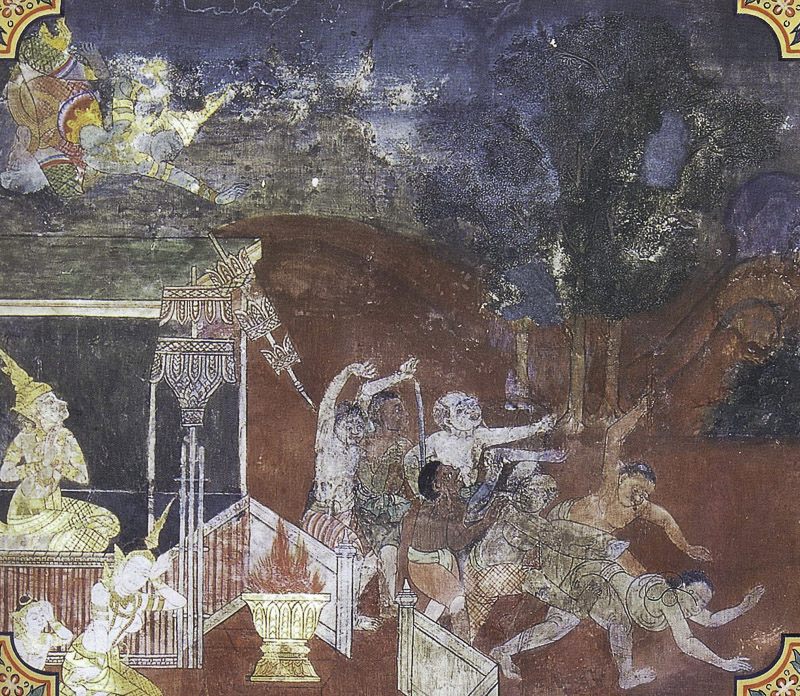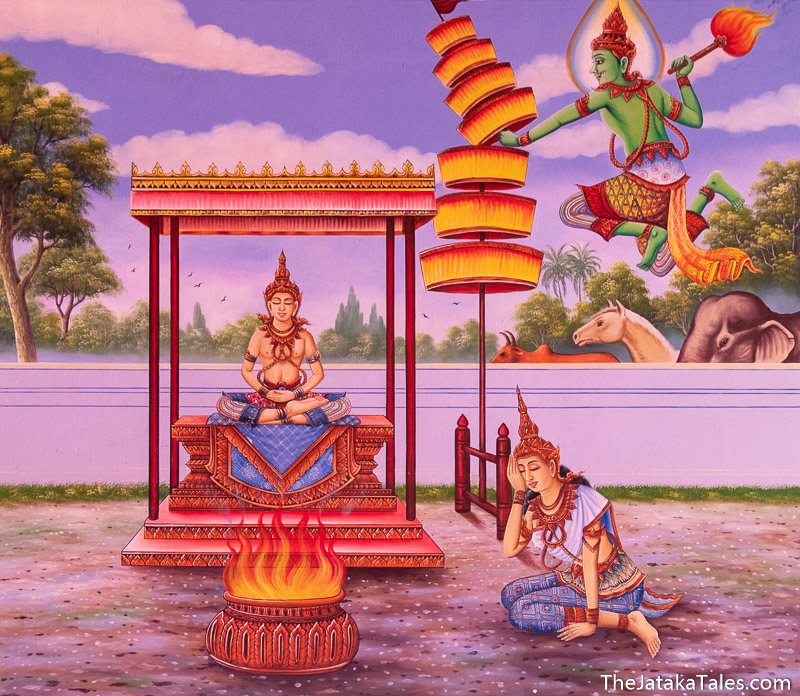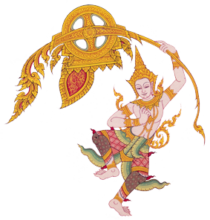This Jataka tale illustrates the perfection of character of patience (khanti).

The Bodhisatta was once a crown prince. The king greatly valued his chaplain and made him a judge, even though he took bribes and cheated people. One time a victim of the chaplain’s corruption left the court after losing his case, even though he had paid a bribe, and saw the Bodhisatta. This man fell at the Bodhisatta’s feet and begged him to tell the king the truth about the chaplain. The Bodhisatta pitied the man, so he took him back to the courthouse and judged the case himself, finding in the man’s favor and granting him the disputed property. The king heard loud applause burst from the courtroom, and when told the reason for it, he appointed the Bodhisatta as judge. The chaplain, suddenly unable to collect bribes, decided to kill the Bodhisatta.
The king was not religious, but after dreaming about heaven he asked his chaplain how to get there. Seizing the opportunity to kill the Bodhisatta, the chaplain told the king he must perform the fourfold sacrifice (killing four of each kind of living creature, from humans to bulls to birds) including four of his wives, sons, and daughters, and four leading merchants. The king told him to arrange it promptly.

While the chaplain ordered a sacrificial pit dug, the king detained his condemned family members and merchants, who were filled with fear and sorrow. He also had his men take his best elephants, horses, mules, and bulls to the pit and go around gathering all the other animals. Citizens protested in the streets and the king’s mother and father pleaded in tears with the king to stop this monstrous act, explaining that killing puts people on the road to hell, not heaven. But the king trusted his chaplain more than anyone else and he would do whatever it took to get into heaven, no matter that killing his family was breaking his heart. The Bodhisatta knew that the chaplain was seeking revenge for losing his job as judge and only wanted him dead: calling for a fourfold sacrifice was a ruse to hide this fact from the king. So the Bodhisatta felt a need to save all the other lives.
Throughout the rest of the day, the Bodhisatta and many others pleaded with the king to come to reason. If this was truly the path to heaven, people said, then let the chaplain kill his family first. Three times the king canceled the sacrifice and had everyone released. But each time the king yielded, the chaplain angrily rushed to the palace and the king succumbed to his sway, ordering the victims recaptured.
The Bodhisatta was the first victim taken to the chopping block. As the chaplain, sword in hand, stood beside the Bodhisatta, the chief queen spoke an act of truth (a solemn declaration of one’s supreme virtue followed by a request for some miraculous result) hoping for divine intervention. Indra, king of the gods, heard her plea, and seeing what was about to befall the Bodhisatta, appeared on earth and frightened the king with a blazing mass of iron and had all the victims set free. A mob stoned the chaplain to death and tried to kill the king too, but Indra stopped them. Instead, the king was banished to an untouchable settlement. The Bodhisatta inherited the crown, and while he never pardoned his father, he did support him through the rest of his life.
In the Lifetime of the Buddha
The chaplain was an earlier birth of Devadatta, a disciple of the Buddha who became his nemesis and wanted to kill him so he could take over as leader of the sangha. With the help of King Ajatasattu, his chief supporter, who had murdered his own father to get the crown, Devadatta hired thirty-one of the best archers in the land and sent one to a spot where the Buddha walked every day. Devadatta told him to use a poison arrow to ensure that the Buddha died and told him which road to return by after the assassination. Then, to cover up his involvement in the murder, Devadatta sent two archers to that road to kill the first archer, four more to kill the next two, eight to kill the four, and sixteen to kill the eight.
The first archer got the Buddha in his sights and drew his bow, but he was filled with the fear of death and could not shoot. The Buddha saw the archer and told him to come near. He fell at the Buddha’s feet, confessed his orders, and begged forgiveness, which was granted. The Buddha explained dharma and then told the archer to go home by a different road than that ordered by Devadatta. The Buddha took Devadatta’s road and met the other archers, preaching dharma and telling them where to walk so they wouldn’t fall into Devadatta’s trap. Their lives saved by the Buddha, all the archers became disciples and eventually arahants.
When the Buddha heard some of his disciples discussing the incident, he told them this story so they knew that this was not the first time Devadatta had tried to kill many people as part of a plan to kill him.
The Bodhisatta’s son and mother and the king’s chief queen were earlier births of the Buddha’s son, birth mother, and wife, and some of the Bodhisatta’s brothers and sisters were earlier births of Sariputta, Moggallana, Maha Kassapa, and Uppalavanna, four of the Buddha’s top disciples.
